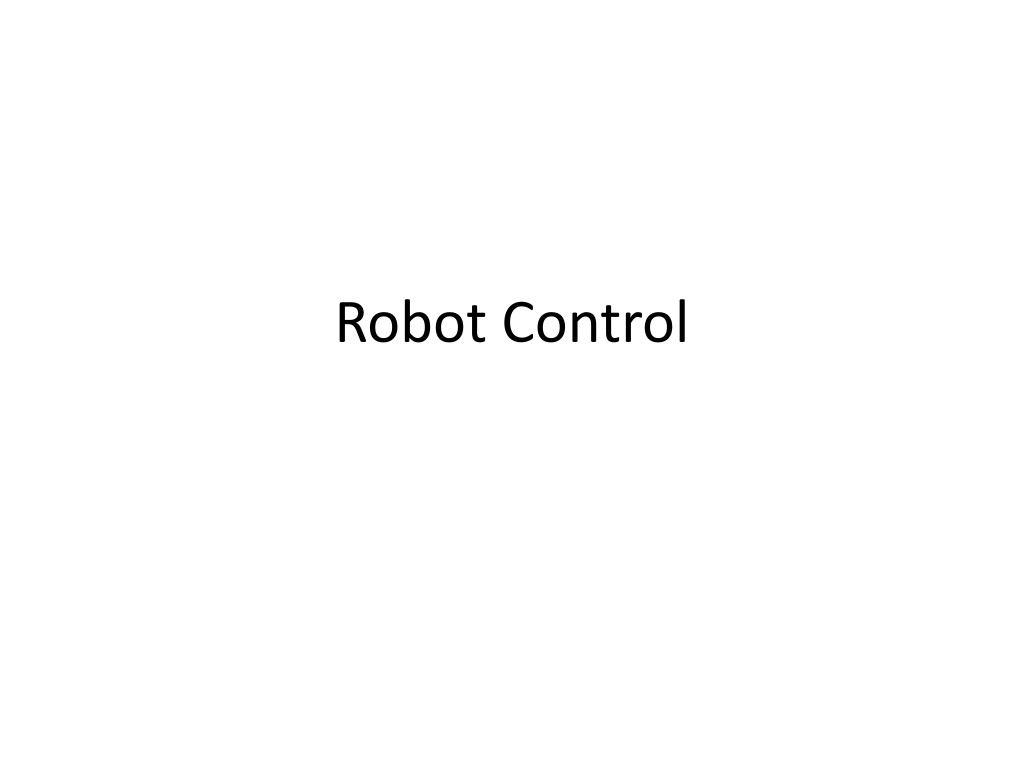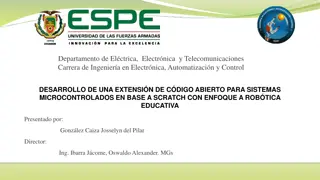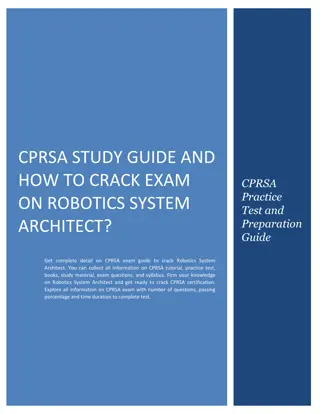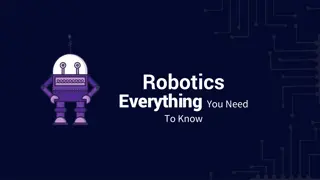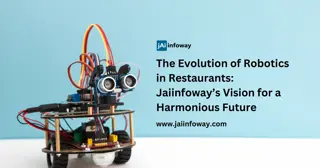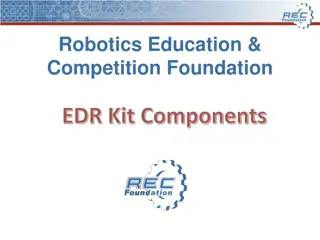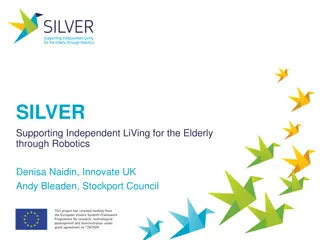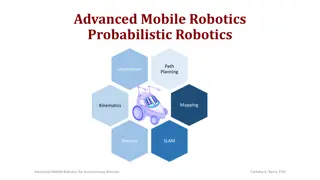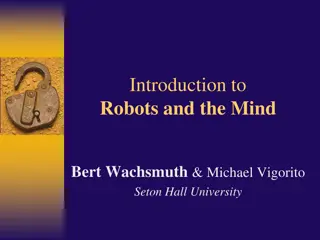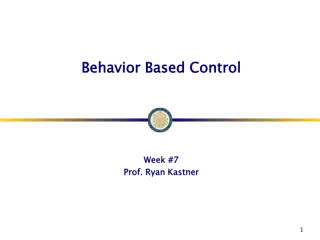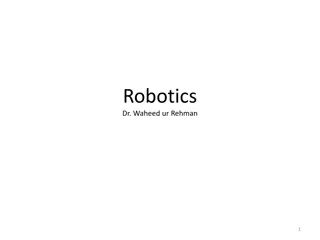Understanding Control Systems in Robotics
Exploring the concepts of open-loop control, closed-loop control (feedback control), goals, error measurement, feedback systems, and real-world feedback examples in the context of robotics. Control systems play a crucial role in directing robots to achieve desired states efficiently. Discover the significance of error minimization and sensor feedback for optimal robot performance.
Download Presentation

Please find below an Image/Link to download the presentation.
The content on the website is provided AS IS for your information and personal use only. It may not be sold, licensed, or shared on other websites without obtaining consent from the author. Download presentation by click this link. If you encounter any issues during the download, it is possible that the publisher has removed the file from their server.
E N D
Presentation Transcript
Open Loop Control Sends commands to make a robot preform some movement without attempting to check if it is doing things properly. For example a rover on Mars being told by a human operator to go forward 1 meter. If the wheels get dirt in them or hit a rock the robot won t move straight.
Feedback or Closed Loop Control Feedback control is a means of getting a system (a robot) to achieve and maintain a desired state, usually called the set point, by continuously comparing its current state with its desired state. Feedback refers to the information that is sent back, literally fed back, into the system s controller.
Goals The desired state of the system, also called the goal state, is where the system wants to be. To reach a goal state, the robot needs maintenance goals. This will require ongoing active work on the part of the system. Keeping a biped robot balanced, for example, is a maintenance goal.
Error The difference between the current state and the goal state of a system is called the error. The control system is designed to minimize that error. Feedback control calculates the error in order to help the robot reach the goal. When the error is zero (or small enough), the goal state is reached.
Feedback System Feedback takes the sensor error and converts it into a command.
Feedback Example As a real world example of error and feedback, let s consider the game that s sometimes called hot and cold, in which you have to find or guess some hidden object, and your friends help you by saying things like You re getting warmer, hotter, colder, freezing and so on.
Imagine a overly simplified version of the same game, in which your friends tell you only You are there, you win! or Nope, you are not there. In that case, what they are telling you is only if the error is zero or non-zero (if you are at the goal state or not). This is not very much information, since it does not help you figure out which way to go in order to get closer to the goal, to minimize the error.
In the normal version of the game, when you are told hot or cold, you are being given the direction of the error, which allows for minimizing the error and getting closer to the goal. When the system knows how far off it is from the goal, it knows the magnitude of error, the distance to the goal state. In the hot and cold game, the gradations of freezing, chilled, cool, warm, and so on are used to indicate the distance from (or closeness to) the goal object.
An Example of a Feedback Control Robot How would you write a controller for a wall-following robot using feedback control?
The first step is to consider the goal of the task. In wall-following, the goal state is a particular distance, or range of distances, from a wall. This is a maintenance goal, since wall- following involves keeping that distance over time.
Given the goal, it is simple to work out the error. In the case of wall-following, the error is the difference between the desired distance from the wall and the actual distance at any point in time. Whenever the robot is at the desired distance (or range of distances), it is in the goal state. Otherwise, it is not.
Sensors What sensor(s) would you use for a wall-following robot and what information would they provide?
The rate with which new distance-to-wall is sensed and computed, is called the sampling rate. https://www.youtube.com/watch?v=eaZ9Gdj9 3kg http://www.humanbenchmark.com/tests/rea ctiontime
Whatever sensor is used, assume that it provides the information to compute distance-to-wall. Consider the following controller: If distance-to-wall is in the desired range, keep moving forward. If distance-to-wall is larger than desired, turn toward the wall, else turn away from the wall.
Given the previous controller algorithm, the robot s behavior will keep it moving and wiggle back and forth as it moves along. How much switching back and forth will it do? That depends on two parameters: How often the error is computed. How much of a correction (turn) is made each time.
Consider the following controller: If distance-to-wall is exactly as desired, keep going. If distance-to-wall is larger than desired, turn by 45 degrees toward the wall, else turn by 45 degrees away from the wall.
It oscillates a great deal and rarely if ever reaches the desired distance before getting too close to or too far from the wall. In general, the behavior of any simple feedback system oscillates around the desired state. Therefore, the robot oscillates around the desired distance from the wall; most of the time it is either too close or too far away.
How can we decrease this oscillation? There are a few things we can do: The first is to compute the error often, so the robot can turn often rather than rarely. Another is to adjust the turning angle so the robot turns by small rather than large angles. Still another is to find just the right range of distances that defines the robot s goal.
Damping refers to the process of systematically decreasing oscillations. A system is properly damped if it does not oscillate out of control. How the motor responds to speed commands plays a key part in control, wear and tear on the gears. Actuatoruncertainty makes it impossible for a robot (or a human, for that matter) to know the exact outcome of an action ahead of time, even for a simple action such as Go forward three feet.
The three most used types feedback control are: Proportional control (P) Proportional Derivative control (PD) Proportional Integral Derivative control (PID)
Proportional Control The basic idea of proportional control is to have the system respond in proportion to the error, using both the direction and the magnitude of the error. It would use distance-to-wall as a parameter to determine the angle and distance and/or speed with which the robot would turn. In control theory, the parameters that determine the magnitude of the system s response are called gains. Damping refers to the process of systematically decreasing oscillations. A system is properly damped if it does not oscillate out of control.
Derivative Control momentum = mass velocity You can control momentum by controlling the velocity of the system. The controller corrects for the momentum of the system as it approaches the desired state. A derivative controller would slow the robot down and decrease the angle of its turning as its distance from the wall gets closer to the desired state, the optimal distance to the wall.
Integral Control The system integrates (sums up) these incremental errors over time, and once they reach some predetermined threshold (once the cumulative error gets large enough), the system does something to compensate/correct. Such as a robot lawn mower with an error when turning to cut sections of grass. With a system to detect the error, it can compensate for it over time.
Proportional Derivative control (PD)control is extremely useful and applied in most industrial plants for process control. Proportional Integral Derivative control (PID) control is a combination of proportional P, integral I, and derivative D control terms.
What Can the Robot Represent? There are numerous aspects of the world that a robot can represent and model, and numerous ways in which it can do it. The robot can represent information about: Self: Battery life, physical limits Environment: navigable spaces, structures Objects, people, other robots: detectable things in the world Actions: outcomes of specific actions in the environment Task: what needs to be done
Control Architectures The job of the controller is to provide the brains for the robot. So the robot can be autonomous and achieve its goals. The robot can sense multiple things at once. A controller will help make decisions what the robot should be observing.
Regardless of which language is used to program a robot, what matters is the control architecture used to implement the controller, because not all architectures are the same.
Deliberative Control Planning is the process of looking ahead at the outcomes of the possible actions, and searching for the sequence of actions that will reach the desired goal. Search is an inherent part of planning. It involves looking through the available representation in search of the goal state.
Deliberative, planner-based architectures involve three steps that need to be performed in sequence: 1. Sensing (S) 2. Planning (P) 3. Acting (A), executing the plan.
Reactive Control You can think of reactive rules as being similar to reflexes, innate responses that do not involve any thinking. The best way to keep a reactive system simple and straightforward is to have each unique situation (state) that can be detected by the robot s sensors trigger only one unique action of the robot. It must support the ability of parallelism, to handle checking multiple sensors.
Hybrid Control Hybrid control involves the combination of reactive and deliberative control within a single robot control system by having: Planner Middle layer that links the layers together (by issuing commands). Reactive layer Uses both Open and Closed execution
Behavior-Based Control Behavior-based control (BBC) involves the use of "behaviors" as modules for control. Behaviors achieve and/or maintain complex goals. A homing behavior achieves the goal of getting the robot to the home location. A wall- following behavior maintains the goal of following a wall. These take time to execute and are not instantaneous. Constantly monitoring the sensors and other behavior statuses.
